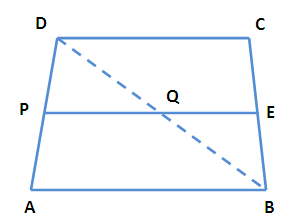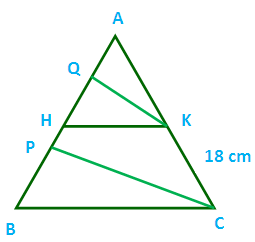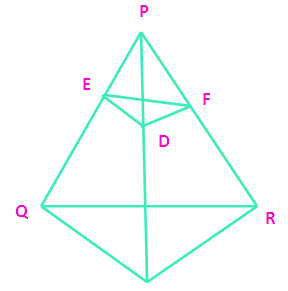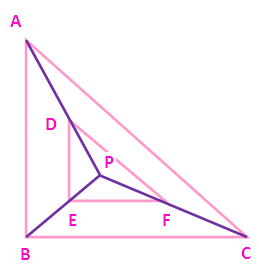PROVING BASIC PROPORTIONALITY THEOREM IN GIVEN TRIANGLE
Subscribe to our ▶️ YouTube channel 🔴 for the latest videos, updates, and tips.
Basic Proportionality Theorem :
If a straight line is drawn parallel to one side of a triangle intersecting the other two sides, then it divides the two sides in the same ratio.
Converse of Basic Proportionality Theorem Examples :
If a line divides any two sides of a triangle in the same ratio, then the line must be parallel to the third side.
Given :
In triangle ABC and a line intersecting AB in D and AC in E, such that AD/DB = AE/EC.
Example 1 :
ABCD is a
quadrilateral with AB parallel to CD. A line drawn parallel to AB meets AD at P
and BC at Q. Prove that AP/PD = BQ/QC.
Solution :

Join BD by intersecting the line PQ at the point Q.
In triangle DAB, PE and AB are parallel, by using “Thales theorem”
AP/PD = BE/ED ----(1)
In triangle BCD EQ and DC are parallel, by using “Thales theorem”
BE/ED = BQ/QC ----(2)
(1) = (2)
AP/PD = BQ/QC
Example 2 :
In t he figure, PC and QK are parallel BC and HK are parallel, if AQ = 6 cm, QH = 4 cm, HP = 5 cm, KC = 18 cm, then find AK and PB.
Solution :

In triangle APC, the sides PC and QK are parallel.
By using “Thales theorem” we get
AQ/QP = AK/KC
QP = QH + HP
= 4 + 5
= 9 cm
6/9 = AK/18
AK = (6 x 18)/9
AK = 12 cm
In triangle ABC, the sides BC and HK are parallel,
By using “Thales theorem” we get
AH/HB = AK/KC
AH = AQ + QH
= 6 + 4
= 10
10/HB = 12/18
(10 x 18)/12 = HB
HB = 15 cm
Now we need to find the length of PB,
PB = HB – HP
= 15 – 5
= 10 cm
Example 3 :
In the figure DE is parallel to AQ and DF is parallel to AR prove that EF is parallel to QR.
Solution :

In triangle PQA, the sides DE is parallel to the side AQ.
By using “Thales theorem” we get
PE/EQ = PD/DA ----(1)
In triangle PAR, the sides DF is parallel to the side AR
By using “Thales theorem” we get
PD/DA = PF/FR ----(2)
(1) = (2)
PE/EQ = PF/FR
From this we can decide EF is parallel to QR in the given triangle PQR.
Example 4 :
In the figure the sides DE and AB are parallel and DF and AC are parallel. Prove that EF and BC are parallel.
Solution :

In triangle APB, the sides DE and AB are parallel.
PD/DA = PE/EB ----(1)
In triangle PAC, the sides DF and AC are parallel.
PD/DA = PF/FC ----(2)
(1) = (2)
PE/EB = PF/FC
Hence the sides EF and BC are parallel.
Subscribe to our ▶️ YouTube channel 🔴 for the latest videos, updates, and tips.
Kindly mail your feedback to v4formath@gmail.com
We always appreciate your feedback.
About Us | Contact Us | Privacy Policy
©All rights reserved. onlinemath4all.com

Recent Articles
-
10 Hard SAT Math Questions (Part - 44)
Jan 12, 26 06:35 AM
10 Hard SAT Math Questions (Part - 44) -
US Common Core K-12 Curricum Algebra Solving Simple Equations
Jan 07, 26 01:53 PM
US Common Core K-12 Curricum Algebra Solving Simple Equations -
10 Hard SAT Math Questions (Part - 4)
Jan 05, 26 06:56 PM
10 Hard SAT Math Questions (Part - 4)
